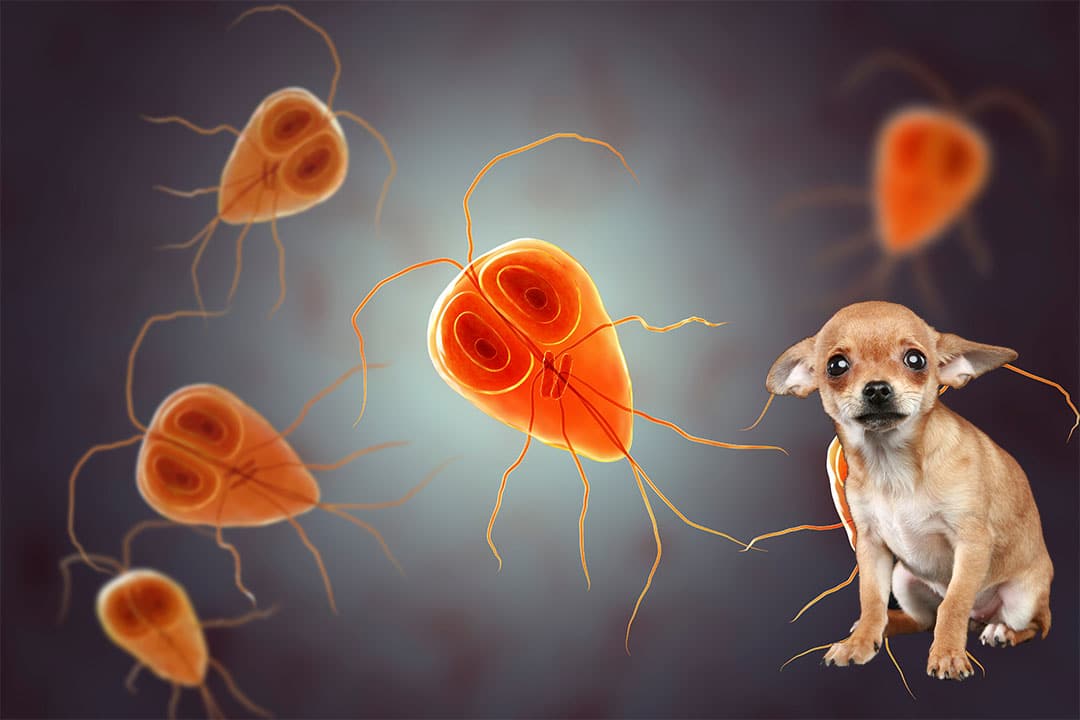Giardiasis Infection and Your Chihuahua
Giardia is a type of protozoan parasite that can affect a number of animals, including dogs and humans Because it can affect humans, it is considered a zoonotic disease. Giardia infection is called giardiasis and most commonly causes diarrhea in dogs ( Chihuahuas ).
What is Giardia?
Giardia is not a worm, but a microscopic single-celled parasite. There are numerous species of Giardia, and not all are known. However, it is known that these organisms live in the intestines of animals in the form of trophozoites.
These trophozoites have long whip-like appendages called flagellates, which enable them to swim throughout the intestines of a host. In the intestines, the trophozoites attach to cells in the small intestine. This leads to maldigestion, malabsorption, and diarrhea.
Outside a host’s body, two trophozoites join to create a protective cyst. This allows them to survive in the environment until they can infect a new host.

How Chihuahuas Get Giardia Infections
Giardia is shed in the stool of affected animals. Giardia cysts can survive in the environment for weeks to months depending on conditions. The cysts thrive in water, living for one to three months. They can survive in cooler soil temperatures for up to 7 weeks and for about a week in warmer soil or on surfaces.
Infection occurs when Giardia cysts are ingested. Chihuahuas contract Giardia by drinking contaminated water, eating off the ground where contaminated soil is present, or self-grooming after coming into contact with contaminated soil, stool, water, or another contaminated surface. Humans are most commonly infected with Giardia after drinking contaminated water. Fortunately, evidence shows that Chihuahuas-to-human transmission of Giardia is rare.
Signs of Giardia in Chihuahuas
The most common sign of Giardia infection is diarrhea that often becomes bloody. Bloating and flatulence may also occur. Many Chihuahuas display general malaise, lethargy, and loss of appetite. Though less common, vomiting sometimes occurs with giardiasis. If left untreated, giardiasis can lead to weight loss, malnourishment, dehydration and more. If you notice these signs (or any other signs of illness) in your Chihuahua, contact your veterinarian.

Diagnosing Giardia in Chihuahuas
Your veterinarian will usually only test specifically for Giardia if your Chihuahua is sick. However, routine wellness parasite screening may reveal the presence of Giardia. Giardiasis is not as simple to diagnose as other common intestinal parasites because it is not consistently shed in the stool (due to the organism’s life cycle). There are a few ways Giardia can be detected by a veterinarian.
- Direct fecal smear: fresh stool is mixed with saline and examined microscopically.
- Fecal flotation with centrifugation: stool is mixed with a special salt/sugar solution and centrifuged (spun in a special machine at high speed). The sample is then microscopically examined.
- Giardia ELISA test: a specialized test that detects antigens in feces. This test uses a small stool sample and a test kit; no microscopic examination is needed. The Giardia ELISA is considered the most effective for diagnosing dogs with giardiasis. Most veterinarians can perform this test in-house for fast results.
Giardia Treatment for Chihuahuas
There are a few ways Giardia infection can be treated in Chihuahuas. Your vet may prescribe a dewormer called fenbendazole (Panacur) to be administered orally for 3-7 days. An antibiotic called metronidazole (Flagyl) may be prescribed concurrently or separately. However, evidence shows that the use of metronidazole alone is less effective.
Though less commonly used, some vets may prescribe a broad-spectrum dewormer called Drontal Plus (a combination of febantel, pyrantel pamoate, and praziquantel) to be administered daily for 3 days. However, this may be cost-prohibitive. Talk to your vet about the best drug options for your Chihuahua.

Giardia Prevention and Control
Regardless of the medical treatment used, it is important that you do your best to eliminate Giardia from your Chihuahua’s environment. This will prevent humans and other dogs from contracting Giardia and prevent your Chihuahua from becoming reinfected.
- Feces should be removed from your yard immediately to minimize the chances of contamination. Scoop the yard at least one to two times daily. Eliminate any standing water in the yard if possible. Unfortunately, it is difficult to fully decontaminate the yard, but keeping it clean minimizes the risk. Some sources suggest steam cleaning as an option outdoors.
- Affected Chihuahuas should be bathed when diagnosed and again after treatment is completed.
- Bedding should be washed frequently during treatment and again when treatment is complete.
- Surfaces can be cleaned using bleach and water at a 1:32 dilution ratio. Or, steam-cleaning can be performed and areas allowed to dry.
Be sure to comply with your veterinarian’s recommendations regarding follow-up.






